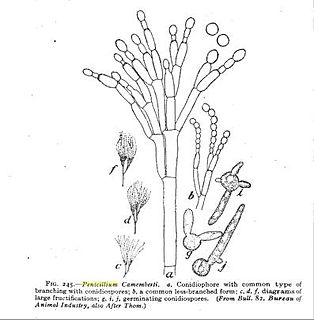
Cow dung, also known as cow pats, cow pies or cow manure, is the waste product of bovine animal species. These species include domestic cattle ("cows"), bison ("buffalo"), yak, and water buffalo. Cow dung is the undigested residue of plant matter which has passed through the animal's gut. The resultant faecal matter is rich in minerals. Color ranges from greenish to blackish, often darkening soon after exposure to air.

Penicillium roqueforti is a common saprotrophic fungus in the genus Penicillium. Widespread in nature, it can be isolated from soil, decaying organic matter, and plants.

Penicillium camemberti is a species of fungus in the genus Penicillium. It is used in the production of Camembert, Brie, Langres, Coulommiers, and Cambozola cheeses, on which colonies of P. camemberti form a hard, white crust. It is responsible for giving these cheeses their distinctive flavors. An allergy to the antibiotic penicillin does not necessarily imply an allergy to cheeses made using P. camemberti.
Penicillium allii-sativi is a fungus species of the genus Penicillium, section Chrysogena. It is one of several Penicillium species that can produce penicillin in culture. The fungus has been found in Argentina, Bulgaria, France, Portugal, South Africa, and the United Kingdom. The specific epithet allii-sativi refers to the garlic plant, Allium sativum, from which the fungus was isolated.
Penicillium confertum is an anamorph fungus species of the genus of Penicillium.
Penicillium desertorum is a species of the genus of Penicillium which was isolated from desert soil under the plant Oryzopsis hymenoides in Wyoming in the US.
Penicillium flavescens is a species of the genus of Penicillium.
Penicillium goetzii is a species of the genus of ascomycetous fungi.
Penicillium halotolerans is a species of the genus of Penicillium which has the ability to tolerate 5% NaCl.
Penicillium allahabadense is an anamorph species of the genus of Penicillium which produces rugulosin.
Penicillium miczynskii is a species of the genus Penicillium which was isolated from soil under conifers in Poland. Penicillium miczynskii produces citreoviridin.
Penicillium mononematosum is an anamorph species of the genus Penicillium which produces viriditoxin.
Penicillium ribium is a psychrotolerant species of the genus of Penicillium which was isolated from the Rocky Mountains in Wyoming, in the United States. Penicillium ribium produces asperfuran, kojic acid and cycloaspeptide.
Penicillium salamii is a species of fungus in the genus Penicillium which occurs on dry-cured meat products.
Penicillium simplicissimum is an anamorph species of fungus in the genus Penicillium which can promote plant growth. This species occurs on food and its primary habitat is in decaying vegetations Penicillium simplicissimum produces verruculogene, fumitremorgene B, penicillic acid, viridicatumtoxin, decarestrictine G, decarestrictine L, decarestrictine H, decarestrictine I, decarestrictine K decarestrictine M, dihydrovermistatin, vermistatin and penisimplicissin
Penicillium subrubescens is a species of the genus of Penicillium which produces high amounts of inulinase.
Penicillium tardochrysogenum is a filamentous species of fungus in the genus Penicillium which produces penicillin, secalonic acids D and secalonic acids F.
Penicillium vanluykii is a species of fungus in the genus Penicillium which produces penicillin.
Penicillium commune is an indoor fungus belonging to the genus of Penicillium. It is known as one of the most common fungi spoilage moulds on cheese. It also grows on and spoils other foods such as meat products and fat-containing products like nuts and margarine. Cyclopiazonic acid and regulovasine A and B are the most important mycotoxins produced by P. commune. The fungus is the only known species to be able to produce both penitrem A and roquefortine. Although this species does not produce penicillin, it has shown to have anti-pathogenic activity. There are no known plant, animal or human diseases caused by P. commune.
Dr. Martha Christensen was an American mycologist, botanist and educator known as an expert in fungal taxonomy and ecology, particularly for soil-dwelling fungi in the genera Aspergillus and Penicillium.






